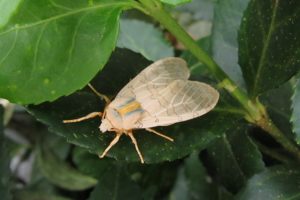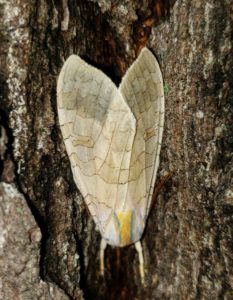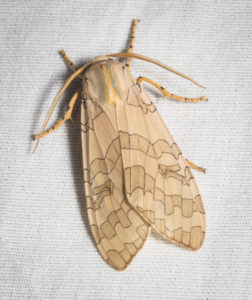Sycamore Tussock Moth (Halysidota harrisii)
Sycamore tussock moth of the Erebidae family is indigenous to northeastern Mexico, eastern United States, and southeastern Canada. As its name suggests, the larva mainly feeds on sycamore trees, also causing damage to the plants.
littlecrumcreek.files.wordpress.com
Scientific Classification
- Family: Erebidae
- Genus: Halysidota
- Scientific Name: Halysidota harrisii
Description and Identification
Caterpillar
They have an orange head and yellowish body with a dense covering of hair. In the front part of the larva’s body lie orange and white hair pencils in pairs of two. Two white hair pencils are also seen behind their body.
Though not poisonous, the hair on the larva’s body could cause itchy rashes to humans if touched with bare hands. It is always advisable to remove them using a paper or stick while removing them from unwanted areas.
Pupa
The cocoons within which the pupa remains encased are hairy resembling a ball, hung near barks, or even kept in areas close to debris. The pupation phase commences from September and October.
Adult Moth
Sexual Dimorphism: Present but not prominent
Color and Appearance: When opened, the wings have a pale yellowish-brown coloration with tan and brown bands running alternately across the forewings. When closed, the pattern and color remain the same.
They even have a hairy thorax bordered in lines of yellow, white, and blue intersecting the center.
Average Wingspan: 5 cm (forewings 2.5 – 3.5 cm long)
Flight Pattern: Consistent
Season: July – September
Egg
The eggs are laid in large masses near the branches or barks of the host plants.
Quick Facts
| Distribution | Southeastern Canada, northeastern Mexico, eastern United States |
| Habitat | Forests, and every other place where their host plant grow |
| Predators | Birds, bats |
| Lifespan of Adults | Not recorded |
| Host Plants | Sycamore |
| Adult Diet | Nectar of host plants |
Scientific Classification
- Family: Erebidae
- Genus: Halysidota
- Scientific Name: Halysidota harrisii




